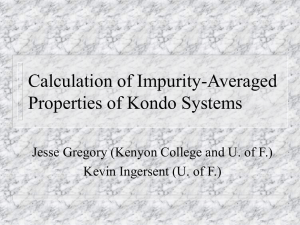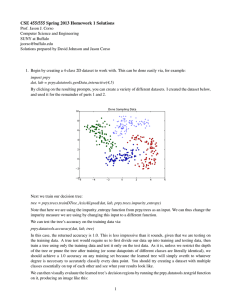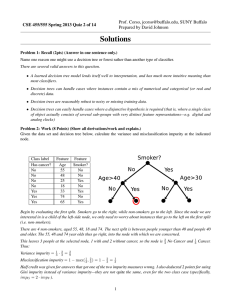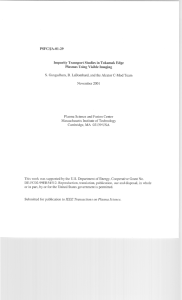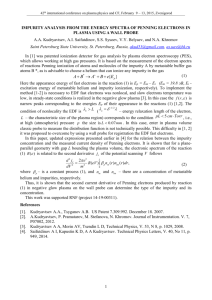Spectroscopic Measurement of Impurity Transport Coefficients and Penetration
advertisement
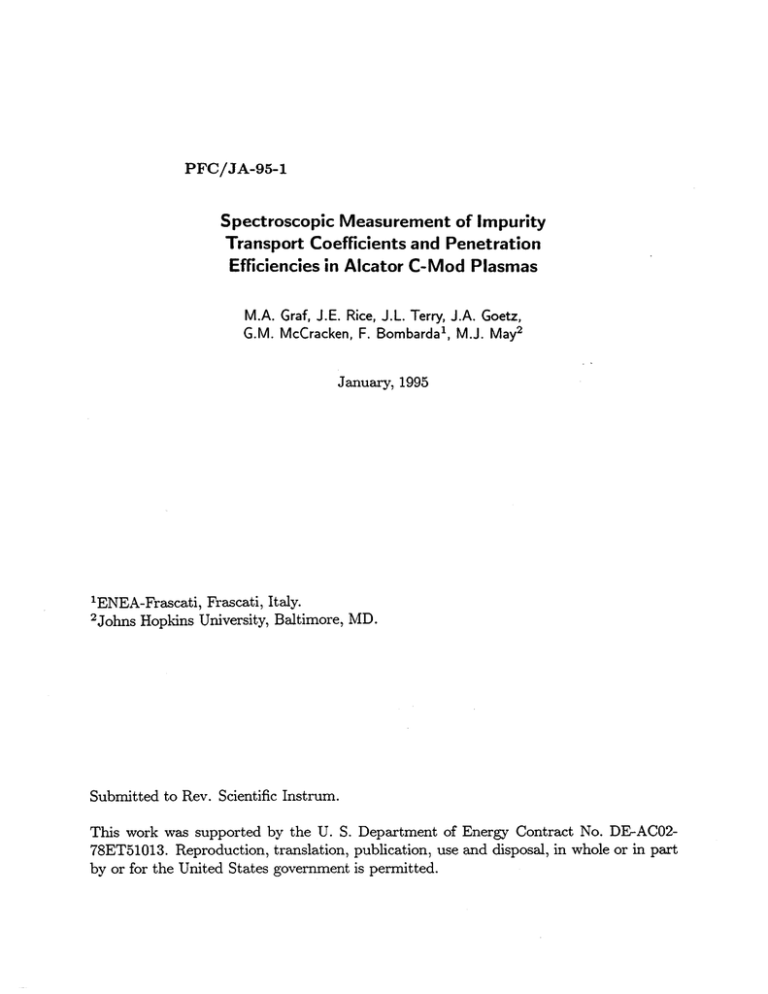
PFC/JA-95-1
Spectroscopic Measurement of Impurity
Transport Coefficients and Penetration
Efficiencies in Alcator C-Mod Plasmas
M.A. Graf, J.E. Rice, J.L. Terry, J.A. Goetz,
G.M. McCracken, F. Bombardal, M.J. May 2
January, 1995
1ENEA-Frascati,
2
Frascati, Italy.
Johns Hopkins University, Baltimore, MD.
Submitted to Rev. Scientific Instrum.
This work was supported by the U. S. Department of Energy Contract No. DE-AC0278ET51013. Reproduction, translation, publication, use and disposal, in whole or in part
by or for the United States government is permitted.
Spectroscopic Measurement of Impurity Transport Coefficients
and Penetration Efficiencies in Alcator C-Mod Plasmas
M.A. Graf, J.E. Rice, J.L. Terry, E.S. Marmar, J.A. Goetz, G.M. McCracken
Plasma Fusion Center, MIT
F. Bombarda
ENEA-Euratom, Frascati,Italy
M.J. May
The Johns Hopkins University, Baltimore, MD
Abstract
Impurity transport coefficients and the penetration efficiencies of
intrinsic and injected impurities through the separatrix of diverted Alcator C-Mod discharges have been measured using x-ray and VUV spectroscopic diagnostics. The dominant low Z intrinsic impurity in C-Mod
is carbon which is found to be present in concentrations of less than
0.5%. Molybdenum, from the plasma facing components, is the dominant high Z impurity and is typically found in concentrations of about
0.02%. Trace amounts of medium and high Z non-recycling impurities
can be injected at the midplane using the laser blow-off technique and
calibrated amounts of recycling, gaseous impurities can be introduced
through fast valves either at the midplane or at various locations in the
divertor chamber. A five chord crystal x-ray spectrometer array with
high spectral resolution is used to provide spatial profiles of high charge
state impurities. An absolutely calibrated, grazing incidence VUV spectrograph with high time resolution and a broad spectral range allows
for the simultaneous measurement of many impurity lines. Various filtered soft x-ray diode arrays allow for spatial reconstructions of plasma
emissivity. The observed brightnesses and emissivities from a number
of impurity lines are used together with the MIST transport code and
a collisional-radiative atomic physics model to determine charge state
density profiles and impurity transport coefficients. Comparisons of the
deduced impurity content with the measured Zeff and total radiated
power of the plasma are made.
1
1
Introduction
The ability to diagnose impurity behaviour in a tokamak with an advanced divertor such as Alcator C-Mod is essential. Absolute impurity
density profiles, radiated power losses in the divertor and the main
plasma, and impurity source penetration rates from the walls and the
divertor plates are all quantities of tremendous interest under a variety of operating conditions. Determination of all of these quantities is
dependent on a sufficient understanding of the impurity transport coefficients (ie. particle diffusivities and convective velocities) which govern
charge state distribution profiles inside the separatrix. It is generally
difficult to measure these coefficients using observations of intrinsic impurities alone, owing to the lack of spatial and temporal control over
intrinsic sources. A superior technique for making these measurements
involves the controlled injection of trace amounts of non-recycling impurities whose evolution in the plasma can then be monitored in space
and time. A system capable of such injections on Alcator C-Mod using
the laser ablation technique [1] has been operated successfully during
the 1993 run campaign. A 3 J Q-switched ruby laser is used to ablate thin films (- 1 pm) of selected metallic and non-metallic materials
from targets located about 1 m from the plasma. The number of atoms
actually incident on the plasma edge during such an injection can be
varied by changing either the laser spot size on the target or the energy
density of the beam. Including the geometry of the beamline path from
target to plasma, a typical spot size of 5 mm results in about 2 x 1017
neutral atoms incident on the plasma edge. Gaseous impurities can be
2
injected through capillary tubes located at several poloidal locations in
the divertor and at the midplane. Impurity puff rates of up to 10 torrl/s, as measured by a differential capacitance manometer, have been
used for argon and neon injections. The locations of these injection
points are shown schematically in Figure 1.
2
Diagnostic Instruments
A variety of spectroscopic instruments is available for the observation
of impurity line emission in a wide range of the spectrum. Among the
more versatile instruments used for these observations is a 2.2m grazing
incidence VUV spectrograph. Operated with a 600 line/mm grating
during the 1993 run campaign, this instrument employs a micro-channel
plate image intensifier and a 1024 element Reticon [2] detector and is
capable of viewing a band of about 50
A in
width in the spectral range
of 50-1000 A with a resolving power from 400-2000. The ultimate time
resolution of the spectrograph is as short as 0.5 ms. The instrument
views along a single chord but is scannable in space from an impact
parameter of about 10 cm above to about 25 cm below the midplane
at the magnetic axis which includes a view through the lower x-point
region of a typical diverted discharge. This viewing geometry is also
shown in Figure 1. The spatial resolution at the plasma is about 2 cm
in the vertical dimension and about 12 cm in the toroidal dimension.
This spectrometer has been absolutely calibrated up to 400
A
at
present. A soft x-ray source and a gas-filled proportional counter [3]
were used to perform the calibration in first, second and third order up
3
to 114
A
through the use of various discrete K, lines (Mg, 0, N, C, B,
Be) with outputs of up to 5 x 10" photons/s/sr. The calibration was
then extended to higher wavelengths using the observed relative intensities of known doublet lines of either intrinsic or injected impurities.
A relatively continuous set of such doublets can be found to bridge the
calibration over the entire wavelength range [4]. The absolute calibration is accurate to within ± 15 % up to 114
A, and
to about i 30 %
at 400 A.
Additional spectroscopic diagnostics used for the analysis of impurity emission include a five chord crystal x-ray spectrometer array in
the 2.5-4.0
A
range [5] and a set of soft x-ray diode arrays with high
spatial resolution [6]. The absolute sensitivity of the x-ray spectrometer has been determined through a consideration of viewing geometry
and the physical properties of the crystal and the detector. The soft
x-ray diode arrays have been relatively calibrated using a broadband
x-ray source. Although they lack the spectral resolution necessary for
some analyses, they are nonetheless useful for determining local plasma
emissivities in the 0.5
3
A
to 10
A
spectral region.
Transport Coefficients
A detailed series of experiments was carried out using laser ablation
injections of 1 pum targets of scandium. Scandium was chosen because
it allowed the largest number of available spectroscopic diagnostics to
be used. At the plasma densities (7Te = 0.8 - 3.0 x 1020 m- 3 ) and temperatures (Teo = 1 - 2 keV) typical of discharges in C-Mod, significant
4
amounts of hydrogen- and helium-like scandium are present. These
charge states of scandium emit strongly in the x-ray, allowing for the
use of the soft x-ray diode arrays and the five chord crystal x-ray spectrometer. In particular, the 1s 2 p - 13 2 resonance line in the helium-like
spectrum, and the Lyman alpha doublet in the hydrogen-like spectrum
are the dominant emitters. The VUV spectrograph is capable of observing the 2p - 2s doublet of lithium like scandium at 279.8
A. Observations
A
and 326.0
of these high charge states show a relatively fast influx
time (a few milliseconds) during which the scandium is being ionized
and transported toward the center of the plasma, followed by a slower
exponential decay (tens of milliseconds) when the scandium is diffusing
outward without any significant recombination occurring. This exponential decay is indicative of the global impurity particle confinement
time. Typical exponential decays are shown in Figure 2, and are found
to be measured consistently with each of the diagnostics used. Variation of this confinement time with changing plasma parameters was
also observed. An increase in confinement was seen as the plasma current was increased over the range of 0.4-1.1 MA. A weak isotopic effect
causing an increase in confinement with increasing mass was seen as the
background gas was changed from hydrogen to deuterium to helium.
The dependence of confinement time on plasma density was seen to
be small. Figure 3 summarizes these observations. Qualitatively, these
trends are similar to the energy confinement time scaling on C-Mod
[7]. Modelling of these injections has been carried out with the MIST
code [8] in order to determine appropriate transport coefficients which
are then be applied to the analysis of other impurities. Good agree5
ment with observed time histories of scandium injections was found for
spatially constant diffusion coefficients in the range of 3.5-5.0 m2 /s and
relatively small values of convection velocities
(<
2 m/s). Investiga-
tion of the dependence of these transport coefficients on the particular
impurity species injected detected no measurable differences.
4
Plasma Impurity Content
Having determined a suitable set of transport coefficients over a range
of typical operating conditions, measurements of impurity densities in
the plasma were possible. By matching observed chordal brightnesses
of particular intrinsic impurity lines with emissivity predictions taken
from MIST and a collisional-radiative atomic physics model [9] and integrated along the instrumental lines of sight, estimates of the total
impurity concentrations in the plasma were made. Information from
different lines of several charge states of a given impurity serves as a
consistency check on the analysis. The dominant high Z impurity in Alcator C-Mod during normal operation is molybdenum from the plasma
facing components. The VUV spectrograph is capable of observing a
number of molybdenum lines. Strongest among these are the 3p - 3s
doublet of sodium-like molybdenum (Mo XXXII) at 127.8 and 176.7
A
and the 3s3p - 3s2 line of magnesium-like molybdenum (Mo XXXI)
at 116.0
A.
Carbon is the dominant low Z impurity in C-Mod. The
Lyman alpha line of hydrogen-like carbon is seen strongly in second
order by the VUV spectrograph. Typical brightnesses of these impurity lines during moderate density ohmic operation and the inferred
6
impurity densities are listed in Table I, along with the expected contribution to Zeff and to the expected total power radiated from the core
by each impurity. Agreement with visible bremsstrahlung and bolometric measurements is good, adding confidence to the quality of the
atomic physics rate coefficients and model. Zeff is generally measured
to be less than 1.4 and the total core radiated power for these typical
discharges is about 300 kW.
4.1
Impurity Penetration
Experiments to measure the penetration of a given source of impurities through the separatrix into the main plasma were also performed.
Using the gas injection and the laser ablation injection systems separately, known amounts of argon and scandium were introduced at
the plasma edge. The x-ray crystal spectrometer array was used to
monitor the brightness of the helium-like resonance, intercombination
and forbidden lines, and the grazing incidence spectrometer was used
to observe the lithium-like 2 p-2 s transitions. From these brightnesses,
analyses using the MIST code yielded total impurity concentrations in
the plasma. For both types of injections, it was found that the fraction of injected particles observed in the core plasma decreased as the
central (and hence the edge) electron density was increased. This is
qualitatively consistent with the increase in shielding expected from a
decreased mean free path of impurity neutrals outside the separatrix.
Particles not penetrating are swept along in the scrape-off layer until
they reach a target plate. Less than 0.5% of the total argon (a recycling
impurity) injected was observed in the core plasma. This compares with
7
about 10% of the total amount of scandium (a non-recycling impurity)
incident on the edge penetrating through to the core. The high directed
energy of the laser blow-off injections (-
1 eV) [1] compared with the
isotropic, less energetic gas injections is responsible for these differences
in penetration. Figure 4 shows a comparison of these shielding effects
for the various injections.
5
Conclusions
Through the use of trace laser ablation injections of non-recycling impurities and a variety of spectroscopic diagnostics, impurity diffusion
coefficients and convection velocities have been measured for a range
of operating conditions in Alcator C-Mod. Using the MIST code and a
collisional-radiative atomic physics model, spatially constant diffusion
coefficients and small convective velocities have been found to be consistent with the observed spatial and temporal behaviour of impurity
line emission over a range of operating parameters. Intrinsic plasma
impurity content has been measured using absolutely calibrated diagnostics in the x-ray and VUV regions of the spectrum and has been
found to be consistent with observed Zeqf from visible bremsstrahlung
and bolometric radiated power measurements.
6
References
1 E.S. Marmar, J.L. Cecchi, S.A. Cohen, Review of Scientific Instruments, 46, 1149 (1975)
2 product sold by EG&G Reticon, Salem, MA 01970
8
3 product sold by J.E. Manson Co. Inc., Concord, MA 01742
4 J.L. Terry, H.L Manning, Plasma Fusion Center Report, PFC/CP86-11 (1986)
5 J.E. Rice, E.S. Marmar, Review of Scientific Instruments, 61, 2753
(1990)
6 R.S. Granetz, L. Wang, Bulletin of the American Physical Society,
37, 1424 (1992)
7 I.H. Hutchinson, Physics of Plasmas, 1 (1994)
8 R.A. Hulse, Nuclear Technology/Fusion, 3, 259 (1983)
9 J.E. Rice, M.A. Graf, et al., submitted to Physics Review A, (1994)
9
typical line brightness
(photons/s/sr/cm 2 )
central impurity
carbon
C VI
3 x 101
2 x 1011
molybdenum
Mo XXXII
2 x 10'
2 x 101
0.1
0.2
15
140
density (cm- 3 )
contribution
to Zeff
contribution to
core radiated
power (kW)
10
Figure and Table Captions
Figure 1: Viewing geometry of the VUV spectrograph along with laser
ablation and gas puff impurity injection locations.
Figure 2: Exponential decays of laser ablation injection of scandium at
t=0.55 s.
Figure 3: Impurity particle confinement time scaling with plasma current and mass of the background gas.
Figure 4: Penetration efficiency of injected scandium and argon.
Table I: Typical ohmic plasma impurity content for e ~ 1 x 1020 m-3
and Te
2 keV.
11
laser ablation
VUV upper
scan limit
----------------- -
..--
VUV central chord
VUV lower
scan limit
...-
Gas-Puff
(28 locations)
Pigure 1
12
--
-
central soft x-ray
0.8
0
a)
0.6
T =
19.6 ms
0.4
-C
0.2
0.01
0.54
0.56
0.58
0.60
0.62
0.64
0.66
VUV spectrograph
2520-
T=
00
20.3 ms
(' 15 .C
1015
0 t
0.54
0.56
x-ray
0.58
spectrometer
0.60
0.62
0.64
0.66
x-ray spectrometer
200
150
U)
.6.
20.7 ms
T=
0
100
50
-
0I
0.54
0.56
0.58
0.60
time (s)
Figure 2
13
0.62
0.64
0.66
impurity particle confinement time(ms)
0
b
0
0
I
I
I
I
I
I
I
I
I
N0
III I
I
I
I
I
I
I
I
I
0
I
I
+
0
I
I
-.
CQO
0
(3
0
C-
:
-
00
0
3
1 7
*0
=- C..
(D (D<
0
I
01
0
C
0
0
Eb
0
0
0
0
0
0
*
0:.,.
*
00
CO
0
I
I
I
I
N)
Figure 3
14
I
II1
% of injected impurities penetrating
0
-~
0
.I
I I
II
I
I
I
I
I
I
(D
pe
~
m1
I
0
0
0
(D
0
N\)
(D
:n
0
ba U4
0
-
0
0
0
0
01
0
0
:3
0
C/)
0
:3
0
I
Uln
Figure 4
15
I
I
I
I I
S
I
